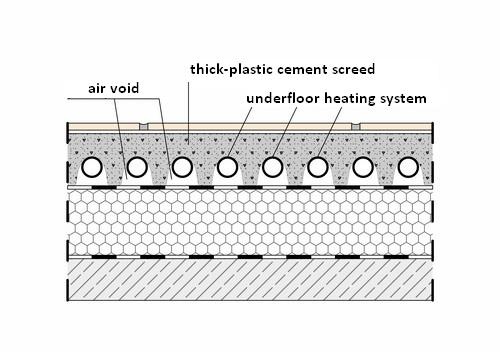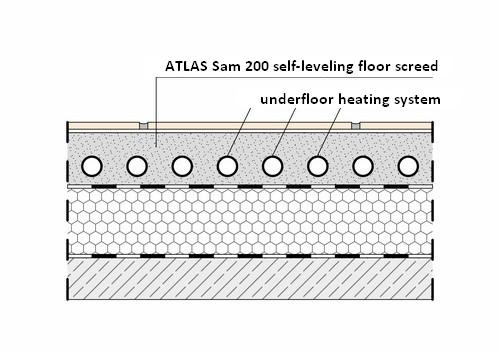- Products
- Systems
- Tools & Services
News
CEMENT OR ANHYDRITE – this is the question
One of the most frequent question asked by the contractors is where to apply cement screed and where the anhydrite one. Does this discourse lead us to a final settlement? No. Both cement and anhydrite screeds have their pros and cons. Let’s take a closer look at them.
Cement and anhydrite – two strong representatives. Both binders bond with the process of hydration with water. Both are mineral. Nevertheless, the difference between them is significant. Cement unlike anhydrite is a binder “resistant” to water and negative temperature. Cement screeds can be used in wet areas (without any restrictions) and outdoors.
From the chemical point of view anhydrite is anhydrous calcium sulfate (CaSO4) – a binder which is very similar to gypsum (formed by dihydrate calcium sulfate – 2H2OCaSO4). Therefore, anhydrite screeds my not be applied outdoors and in wet areas (e.g. in a bathroom).
Why? Due to the fact that the screed cannot be poured on a floor where the “water load” is significant.
Cement screed
There can be much to tell about the advantages of the cement screeds. Generally speaking, they are mortars of thick-plastic consistency. Usually we need to add approx. 1.75-3.75 litres of water per 25 kg bag. This makes them an ideal material for forming slopes on terraces and balconies. Furthermore, cement (combined with an appropriate aggregate) provides significantly higher compressive and flexural strength. Thus, cement screeds are strongly recommended in, e.g. industrial, farm and service facilities where higher the strength and the abrasion resistance are required.
In ATLAS portfolio: Postar 10, Postar 20, Postar 40, Postar 80, Postar 100
Anhydrite screed
Anhydrite screeds are always manufactured as self-leveling mortars of liquid consistency. One needs to add approx. 4.25-6.25 litres of water per 25 kg bag. Liquid consistency ensures easy manual and machine application. Moreover, it provides perfectly leveled and even screed surface. Therefore, anhydrite screeds are recommended beneath the top floor finishes: panels, PVC flooring and carpets. That is why the anhydrite screeds are most often used in the living and office rooms.
Technically the anhydrite screed is a non-shrink material. This is an important feature in view of performing the expansion joints. When executing cement screed, the areas divided with expansion joints must not exceed 36 m2. On the other hand, in case of anhydrite screed, the adequate areas may have up to 60 m2, whereas the diagonal of the room may be up to 10-12 m long. This is due to significantly lower shrinkage of the anhydrite compounds during the bonding process.
In ATLAS portfolio: Sam 150, Sam 200, SWS
Use
Tables 1 and 2 show the advantage of particular screed depending on a feature. We show here conditions of screed use, the most important screeds parameters, as well as the locations in which it is particularly recommended to use one of the screed types. The use of screeds, in case of floors with the underfloor heating, will be discussed separately. According to manufacturers’ technical data sheets both anhydrite and cement based screeds can be used on floors with underfloor heating.
Based on the interpretation of the physical parameters one can draw a conclusion that anhydrite screed is slightly a better heat conductor and that it heats up quicker. It is also important to note that the liquid consistency of anhydrite screeds enables more accurate filling of the spaces between the heating system elements. Anhydrite screed easily “surrounds” the elements of the system. Furthermore, the air voids remaining in the bottom part of the thick-plastic cement screed work as a good insulator, so they limit the heat flow from the system to the substrate.


Surface finishes
The self-leveling surface finishes (both anhydrite and cement) are also screeds types, but they are specific. Their maximum thickness is 30 mm. Moreover, they can be applied only as bonded floors. In case of ATLAS self-leveling surface finishes, regardless of whether they are based on anhydrite or cement, they both can be used indoors only. This results from the recipes of these products. The chemical additives included in the formula provide excellent spreading and quick setting time. However, they are unfortunately not resistant to outdoor conditions. It is therefore difficult to tell which type of surface finish is in the lead.
Of course all cement finishes may be used in bathrooms and wet rooms. The range of use of both finishes types is similar – they are used for smoothing the existing screeds in order to enable covering them with carpets or parquets. So, there can be only one verdict – a draw. The additional points may be given to the cement finishes due to the fact that they dry faster than the anhydrite ones. Thus, one may apply the finishing top layer sooner.
In ATLAS portfolio: SMS 15, SMS 30, Sam 55, Sam 100, Aval KN 10
|
Table 1: Crucial features of anhydrite and cement screeds – comparison |
||||||||
|
|
Wet rooms |
Size of areas between expansion joints |
Layer evenness and smoothness |
Easy in application |
Strength |
Abrasion resistance |
||
|
Advantage of anhydrite |
|
X |
X |
X |
|
|
||
|
Advantage of cement |
X |
|
|
|
X |
X |
||
|
Table 2: Use of anhydrite and cement screeds – comparison |
||||||||
|
|
Slope layer on balconies and terraces |
Underfloor heating |
Outdoor use |
|||||
|
Advantage of anhydrite |
|
X |
|
|||||
|
Advantage of cement |
X |
|
X |
|||||
Is it necessary to grind anhydrite finishes? Or is it only required when tarnish appears on the surface.
It all depends on whether there appears tarnish* on the finish/screed surface. Tarnish is a thin, cream-colour layer of low resistance. If there is tarnish on the surface, which is not that rare in case of anhydrite-based finishes, the surface must be grinded. Removal of the tarnish accelerates the process of drying. In addition, it accelerates the moisture release. Therefore, the finish reaches its optimum moisture content, so that the works may be continued.
If we use ATLAS Sam 200 screed type then the work may be continued the next day. After one day from the application the mass is hard enough and one can enter the floor surface. However, we still need to be careful – the mass tends to “smear”. One solution to this problem is to remove blemish by shearing it with a steel float. However, if we let the entire surface dry, we can solve the problem by grinding the surface – preferably mechanically (tarnish generally bonds slower than the actual compound). There is no rule on the range of strength and work needed – some anhydrite-based products are grinded as easy as polymer finishes and some definitely harder.
* Tarnish (ettringite) – a layer which forms a coating in the form of crystalline white needles. However, it does not occur everywhere. It occurs in mortars based on anhydrite, e.g. ATLAS Sam 200 or Portland cement. It works as a bonding activator, the anhydrite slurry would not bond or harden without it. Ettringite is a result of certain chemical reactions. It may increase its volume from 30 up to even 800%, causing delamination, flaking and peeling of the top finish layers.
Original text: Krzysztof Szyszko, ATLAS Group
English text: Piotr Marciniak, Michał Gosławski, ATLAS GROUP











